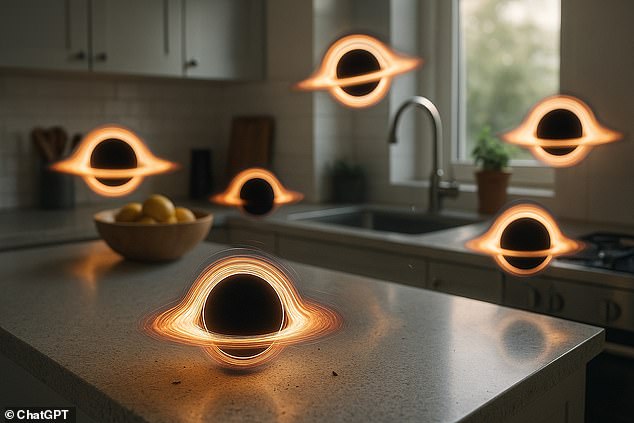
Mini Black Holes May Lurk Undetected in Household Environments, Scientists Propose
Tiny Black holes May Be Passing Through Your Home Right Now – Here’s What You Need to Know
Black holes, often depicted as cosmic monsters devouring stars, might be closer than you think. Thousands of microscopic primordial black holes—remnants of the Big Bang—could be drifting through Earth every year, even through your home… and you’d never notice.
What Are Primordial Black Holes?
Primordial black holes (PBHs) are ancient objects theorized to have formed from dense matter fluctuations in the first moments after the Big Bang. Unlike the supermassive black holes born from collapsing stars, these are tiny, spanning from the size of a bacterium to an asteroid. Some may weigh as little as a grain of salt or as much as a planet.

Primordial black holes could be flooding the universe undetected (AI impression).
Dark Matter Candidates
Scientists propose PBHs may solve the mystery of dark matter—the invisible substance making up 27% of the universe. Dark matter’s gravity binds galaxies, but its origin remains unknown. PBHs, being nearly undetectable and massive, fit the bill. If they exist, they could lurk throughout our solar system.

Primordial black holes (right) likely formed differently than supermassive ones (left).
How Many Are Nearby?
Their abundance depends on their mass. If they’re asteroid-sized, researchers estimate dozens could exist within our solar system, with one passing near Earth every 20 years. Smaller PBHs—microgram-sized “Planck remnants”—might number 1,000 per square meter of Earth annually.
Dr. Sarah Geller (UC Santa Cruz) explains: “If PBHs account for all dark matter, there’s likely one within Jupiter’s orbit.” However, lighter PBHs would be far more numerous but harmless.

If PBHs exist, some may be closer than we think.
Could One Hit You?
If a PBH passed through you, the result depends on its mass. Most are too small to matter. A microgram PBH would zip through unnoticed—like a neutrino. Even asteroid-mass PBHs, though rare, might leave only a microscopic tunnel in their wake. However, mid-sized PBHs (trillion-ton mass) could hit with bullet-like force.
“It’d be like a .22-caliber shot,” says Dr. Geller. While deadly, the chance of collision is astronomically low—like “hitting a single blade of grass with a peanut dropped from a plane.”

A larger PBH collision would be catastrophic but incredibly rare.
Why Haven’t We Detected Them?
PBHs emit faint Hawking radiation, but most are too small or stable to observe. Scientists hunt for gravitational lensing effects or unique radiation bursts. Recent models suggest PBHs might slow their evaporation, lingering longer than expected.
While eerie, PBHs pose no real threat. Their potential role in dark matter keeps them in scientific focus. As researcher Valentin Thoss notes, “PBHs are the least exotic dark matter possibility left.” So rest easy—these cosmic ghosts likely pass by silently, leaving no trace.

Tiny PBHs lose mass via Hawking radiation but may stabilize over time.
In short: PBHs are fascinating relics of the cosmos. While thousands may buzz through your home yearly, their impact—literal and figurative—is vanishingly small.


